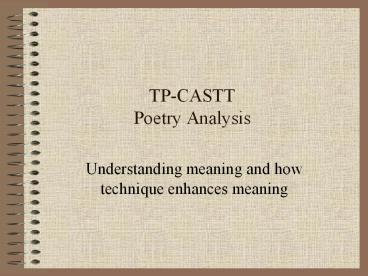TP-CASTT Poetry Analysis - PowerPoint PPT Presentation
Title:
TP-CASTT Poetry Analysis
Description:
TP-CASTT Poetry Analysis Understanding meaning and how technique enhances meaning Summary of TP-CASTT Analysis Title Ponder the title before reading the poem. – PowerPoint PPT presentation
Number of Views:249
Avg rating:3.0/5.0
Title: TP-CASTT Poetry Analysis
1
TP-CASTTPoetry Analysis
- Understanding meaning and how technique enhances
meaning
2
Summary of TP-CASTT Analysis
Title Ponder the title before reading the poem.
Paraphrase Translate the poem into our own words.
Connotation Contemplate the poem for meaning beyond the literal.
Attitude Observe both the speakers and the poets attitude (tone).
Shifts Note shifts in speaker and in attitudes
Title Examine the title again, this time on an interpretive level.
Theme Determine what the poet is saying.
3
Title
- Ponder the title before reading the poem.
- Write your first impressions of the title.
- Predict such elements as mood, tone, and theme,
for example.
4
Paraphrase
- Translate the poem into your own words.
- This is more difficult with modern poems that are
more similar to your own diction and syntax. - For longer poems, work in stanzas, for shorter
poems, work line by line. - Focus on the literal, denotative use of the
words, not the deeper meaning.
5
Connotation
- Contemplate the poem for meaning beyond the
literal. - What is the speaker actually conveying with their
words? - You should note holistic connotations present in
complete stanzas - Include specific choices of diction, idioms,
punctuation, etc.
6
Attitude
- Observe both the speakers attitude (mood) and
the poets attitude (tone). - Go beyond simply naming the tone and mood
explain how these are created. - Comment on specific words, phrases, poetic
devices, punctuation, etc. that the poet employs
to convey attitude.
7
Shifts
- Note shifts in speaker, point of view, attitude,
time, diction, syntax, punctuation, etc. - Go beyond identifying the shift and its location
in the poem how is it created? - Be specific.
8
Title
- Examine the title again, this time on an
interpretive level. - What new insights do you have on the title after
reading the poem? - Note such elements as sarcasm, understatement,
attitude, etc.
9
Theme
- Determine what the poet not the speaker-- is
saying. - What affect does the poet want the poem to have
on the reader? - A single word may be a symbol or a motif, but not
a theme. - Themes are complete sentences, in the third
person, stated as a universal truth.































